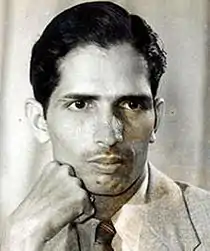Kattingeri Krishna Hebbar
Kattingeri Krishna Hebbar (June 15, 1911 – March 26, 1996)[1] better known as K.K. Hebbar was a celebrated artist known for his India themed artworks.[2]
K.K.Hebbar | |
|---|---|
 K K Hebbar in Bombay on 11 December 1945. | |
| Born | Kattingeri Krishna Hebbar June 15, 1911 |
| Died | 26 March 1996 |
| Nationality | Indian |
| Education | Académie Julian J. J. School of Art |
| Known for | Painting |
| Awards | Padma Bhushan Padma Shri Fellowship of the Lalit Kala Akademi |
Early life
Kattingeri Krishna Hebbar was born in 1911[3] in Kattingeri near Udupi, India in a Kannada speaking Shivalli Madhwa Brahmin family.[4] Hebbar was inclined towards art from his childhood, because his father was an occasional sculptor who used to make Ganesha idols. Coming from an artistic family background Hebbar pursued art and formally studied at the J. J. School of Art (Sir Jamsetjee Jeejebhoy School of Art) in Mumbai between 1940 and 1945.[5] Later he studied art at the Académie Julian in Paris. He was corresponding Member of the Academy of Arts, Berlin between 1975 and 1993.
Career
Hebbar's early artworks were called his Kerala phase because of his depiction of the landscapes of the regions of Malabar and Tulu Nadu. Later he experimented with other themes. Hebbar drew inspiration from myriad sources including the writings of art historian Ananda Coomaraswamy, Jain manuscripts, Rajput and Mughal miniatures, the paintings at the Ajanta Caves, and the art of Amrita Sher-Gil. He also studied at the Academie Julian in Paris, where he developed his appreciation for European modernism.[6] He first won international audiences at the Art Now In India exhibitions in 1965 which were held in London and Brussels. Hebbar participated in various international art exhibitions like the Venice Biennale, São Paulo Art Biennial and Tokyo Biennale. Today, his artworks are considered highly influential in Indian Art History.
Sketches and Paintings
- Krishna and the Panchajanya
- Arjuna's Dejection
- Krishna the Charioteer
- The Forest
- The Birth of Bangladesh
- The Veena
- Lord of the Land
- Cock Fight
- The Tamasha Folkdance
- The Tamasha Folkdance
- The Multi-faceted Shiavaram Karanth
- Divesting of Draupadi[2]
Awards
Hebbar won many awards throughout his lifetime including India's fourth and third highest civilian awards the Padma Shri and the Padma Bhushan.[7] Other of his awards include Academy of Fine Arts, Kolkata, the Bombay Art Society Award, the Bombay State Award, the Lalit Kala Akademi Award, Varna Shilpi K Venkatappa Award, an honorary doctorate from Mysore University, Soviet Land Nehru Award.
References
- "K. K. Hebbar by Purnima Varman". Archived from the original on 14 January 2010. Retrieved 26 July 2015.
- "Kamat's Potpourri: Art of K.K. Hebbar". www.kamat.com. Retrieved 26 July 2015.
- "K K Hebbar". www.havanltd.in. Archived from the original on 3 March 2016. Retrieved 26 July 2015.
- Alonzo Simpson McDaniel (1990). The Absorption of Hydrocarbon Gases by Non-aqueous Liquids. University of Wisconsin--Madison. p. 124.
Kattingeri Krishna Hebbar was born on 15 June 1912 at Kattingeri, a village in Udupi Taluk of Dakshina Kannada District of coastal Karnataka, in a middle-class Kannada- speaking, Madhwa, Shivalli Brahman family.
- Benezit Dictionary of Artists
- Singh, Kishore (2015). India Modern: Narratives from 20th Century Indian Art. New York City: Delhi Art Gallery.
- "Padma Awards" (PDF). Ministry of Home Affairs, Government of India. 2015. Archived from the original (PDF) on 15 November 2014. Retrieved 21 July 2015.